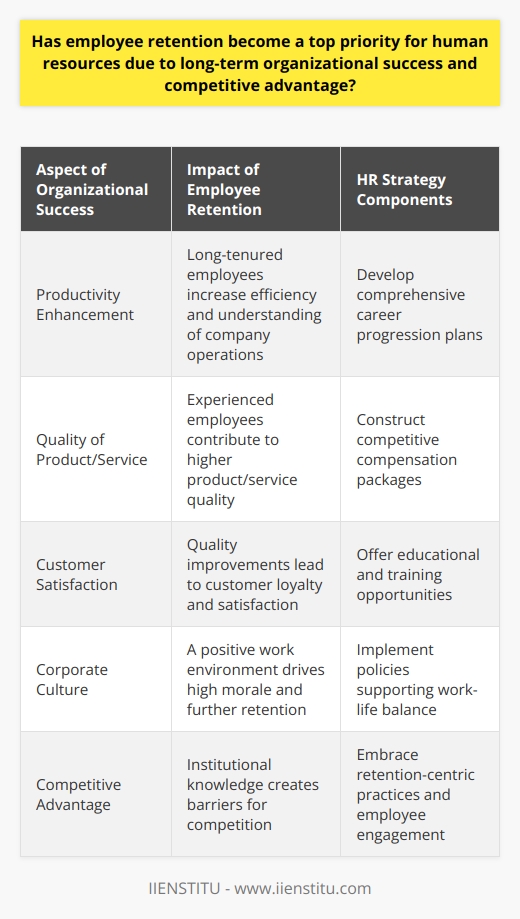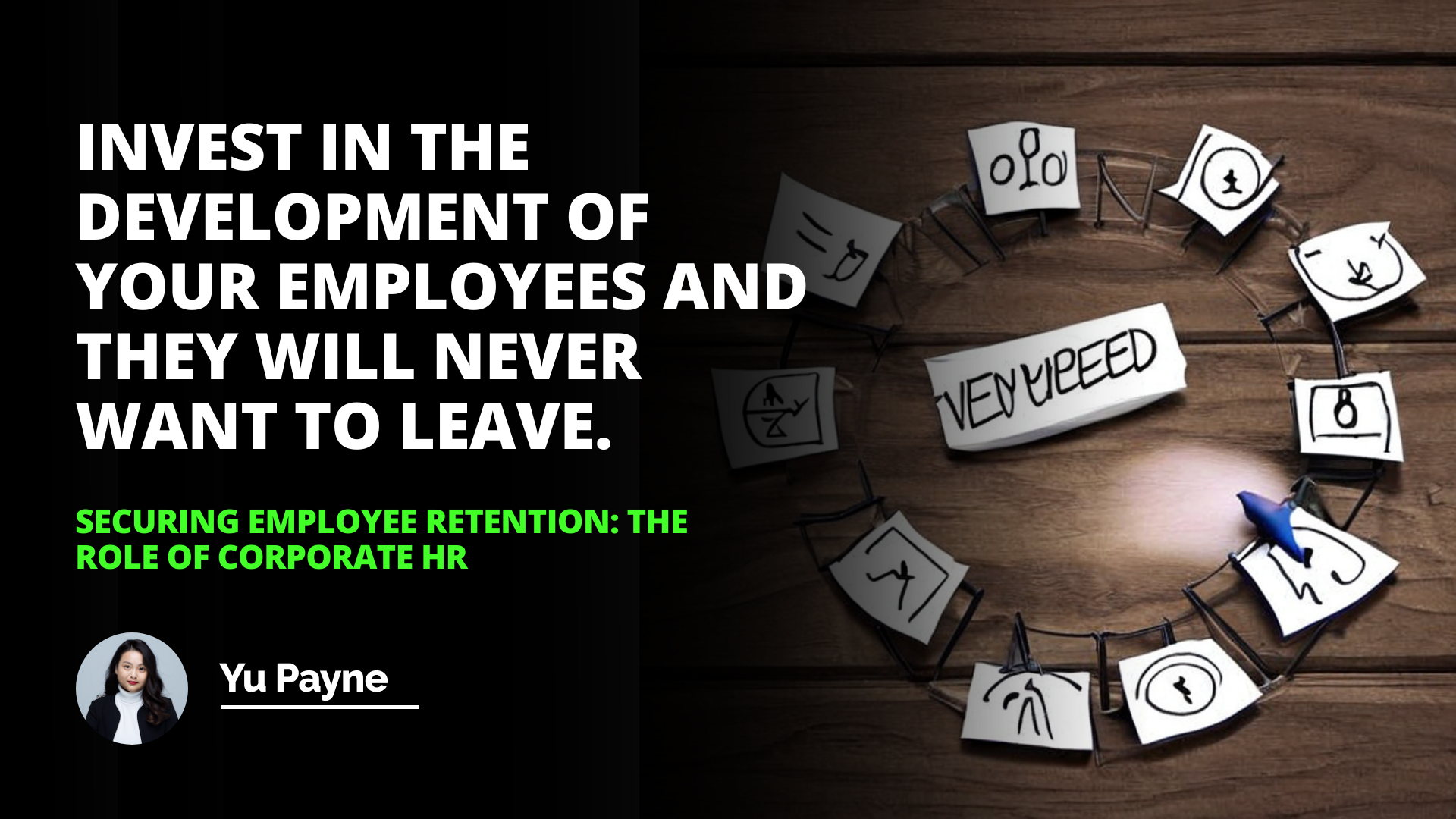
Corporate HR and Employee Retention
Key Strategies for Retention
Challenges of Employee Retention
Employee retention—an organization's ability to retain its most valued employees—has become increasingly important as organizations strive to stay competitive in today's dynamic business environment. It has been widely noted that the costs associated with employee turnover are high, and organizations are looking for ways to reduce these costs. Corporate Human Resources (HR), as a function, has a vital role in securing employee retention. In this blog post, we will discuss the role of corporate HR and strategies for employee retention, and the challenges associated with ensuring employee retention.
Corporate HR and Employee Retention
The role of HR in any organization is to ensure that the organization is staffed in an effective, efficient, and equitable manner and that the employees are managed in a way that enables them to develop their full potential. Regarding employee retention, HR plays a crucial role in developing organizational policies and programs that motivate employees to remain with the organization. In addition, HR can facilitate employee engagement activities and ensure that employees have access to the necessary resources and support.
Key Strategies for Retention
Competitive Compensation: Organizations should ensure that employees have access to competitive salaries and other forms of compensation, such as bonuses, stock options, and other benefits.
Career Development Opportunities: Organizations must provide employees with opportunities to develop their skills and take on new roles and responsibilities.
Positive Work Environment: Organizations should strive to create a positive work environment that is inclusive, supportive, and encourages open communication.
Recognize and Reward Good Work: Organizations should recognize and reward employees for their excellent work and contributions to the organization.
Flexible Work Arrangements: Organizations should strive to offer flexible work arrangements that allow employees to balance their work and personal lives.
Challenges of Employee Retention
Organizations may face several challenges securing employee retention, including limited resources and employee conflicts.
Limited Resources
Organizations can face limited financial resources, which can make it difficult to offer competitive compensation packages, career development opportunities, and other benefits that can help retain employees. In addition, additional resources, such as time, can also be constrained, making it challenging to create and implement employee retention strategies.
Conflict Resolution
Conflicts between employees can also lead to a decline in employee retention. Therefore, organizations must create a positive and inclusive environment where conflicts can be managed in a productive and beneficial way for all employees.
Conclusion: Employee retention is an essential aspect of organizational success. Corporate HR is vital in securing employee retention by developing administrative policies and programs that motivate employees to remain with the organization. Critical strategies for employee retention include offering competitive compensation, providing essential career development opportunities, creating a positive work environment, recognizing and rewarding good work, and offering flexible work arrangements.
Organizations may face challenges securing employee retention, such as limited financial resources and employee conflicts. Therefore, organizations need to develop effective strategies for addressing these challenges to ensure the successful retention of employees.
Invest in the development of your employees, and they will never want to leave.

Frequently Asked Questions
What role does corporate Human Resources play in securing employee retention?
The role of corporate Human Resources (HR) in securing employee retention should not be underestimated. Companies must continuously strive to retain their employees' talents through programs and policies implemented by HR. Employee retention can be a tricky balancing act between reward, recognition, and career advancement. However, suppose a company can foster loyalty and morale within its organization. In that case, it can help reduce the likelihood of attrition and turnover and secure a more positive and loyal employee base.
To secure employee retention, HR professionals should focus on being proactive. One way this can be accomplished is through regular communication with employees about company policies, procedural changes, and any other information that may affect them. This proactive communication demonstrates that the company values employees' opinions and is interested in their growth. Furthermore, regular employee performance reviews should be conducted, bringing in the necessary interventions to address any issues. Thoughts can also serve as an opportunity to reward and recognize good performance.
In addition, HR departments should maintain an open-door policy, providing employees with an outlet to ask questions or express their feelings. Companies should also strive to create a culture of recognition, allowing employees to feel valued, engaged, and motivated. Furthermore, policies and procedures should be implemented to protect employee rights, such as equal opportunity or flexible working.
Finally, HR departments should strive to create an employee retention strategy, considering salary, job security, benefits, and career development.
For example, offering rewards and recognition for longer-term employment is an effective way to increase loyalty and reduce attrition while recognizing a longer-term commitment. Additionally, mentoring and learning opportunities can help ensure that employees have the necessary skills and resources to stay within the company, as well as aid them in their career progression.
In summary, HR departments must be proactive in employee retention, aiming to be informed and communicative, create a culture of recognition, ensure legal rights, and institute an effective employee retention strategy. Doing so can reduce turnover, maintain a loyal, motivated employee base, and provide a higher quality of work and an improved bottom line.
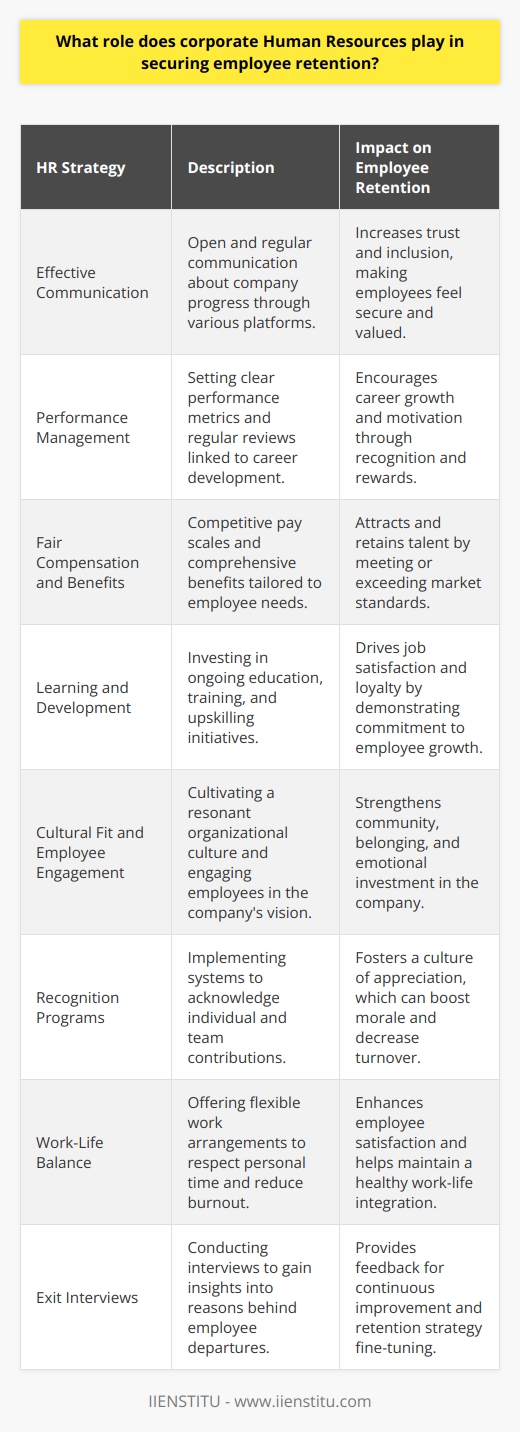
How can HR best motivate, retain, and develop employees?
One of the critical elements of a successful business is having a motivated and productive workforce. Therefore, the HR department ensures that employees are motivated, retained, and developed. To achieve this, HR needs to adopt several best practices.
First and foremost, HR must ensure that employees have a positive work culture. Motivating employees means ensuring a culture of openness, support, and recognition. This involves providing employees with a sense of job satisfaction and autonomy. Open communication between managers and employees is essential to ensure that employees feel well-understood and appreciated. Furthermore, managers should provide regular feedback and display empathy in their interactions with employees. Finally, HR should recognize employee achievements through rewards and incentives.
Secondly, HR needs to ensure employee retention. This includes providing employees with job security and meaningful work opportunities. Additionally, employees should have appropriate career development opportunities and be provided with the necessary skills or training. Benefits and salary should also be considered to ensure that employees remain with the company.
Finally, HR needs to ensure that employees are developed. This involves assessing the competencies of current employees and providing them with appropriate training to improve and enhance these competencies. Employees should also be encouraged to take on new, challenging roles to develop their skills further. HR should also provide mentorship and leadership opportunities to further develop employees' skills and capabilities. Furthermore, HR needs to ensure that employees have the necessary resources to work effectively, now and in the future.
In conclusion, the HR department is critical in motivating, retaining, and developing employees. To do so, best practices must be adopted, such as creating a positive work culture, providing meaningful opportunities and support, and providing employees with the necessary resources to develop their skills. Ultimately, these measures are essential for a business to succeed.

What technologies are available to assist in creating an engaging workplace that facilitates employee retention?
As businesses strive to cultivate a workplace that encourages employees to remain in the workplace, technology is playing an increasingly important role. In this article, we will explore the technologies available to employers that can assist in creating an engaging workplace that facilitates employee retention.
Firstly, employers can take advantage of digital collaboration spaces. These consist of cloud-based software that features a range of tools to facilitate project planning, organization, and communication between employees. This not only brings individuals closer together and bolsters collaboration, but it also enables employers to track and monitor employees' progress on the job.
Additionally, employers can adopt a conversational AI interface. This technology helps minimize distractions, allowing employees to stay connected and respond quickly to emails, chats, and diary reminders. Employers can also use this technology to deliver targeted messages on employee well-being and provide advice on career development.
Alongside this, employers should implement an employee feedback platform. This technology enables employees to provide anonymous feedback that can be tracked and monitored in real-time. This information can then identify key areas of improvement and ensure that employees remain motivated and engaged in the workplace.
The use of coworking technology is also becoming increasingly popular among employers. This includes online networks that enable employees to collaborate and discuss work-related topics, share ideas, research, and gain insights.
Finally, employers can utilize mobile applications that encourage collaboration and personal development. These apps provide a platform for employees to easily access and share resources, from job postings and personalized training modules to company news, business tools, and more.
Adopting these technologies can enable employers to create a workplace that allows employees to manage their work duties and tasks better, encourages collaboration, and allows employees to develop their skills and grow. This, in turn, can help to foster an environment that facilitates employee retention.
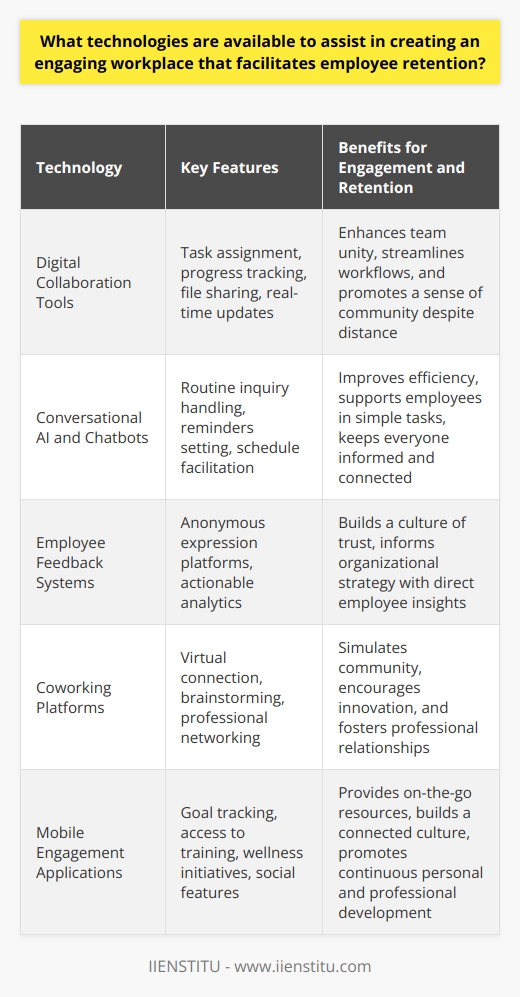
What is the role of HR in creating a work environment that promotes employee retention?
The Role of HR in Employee Retention
Human Resources (HR) is vital in fostering a work environment that encourages employee retention. A major aspect of this responsibility involves recruiting and selecting the right candidates who will thrive within the company culture. HR professionals must be diligent in creating informative and enticing job postings, conducting thorough interviews and assessments, and ensuring the onboarding process is smooth and welcoming.
Effective Communication
In order to retain employees, HR must establish a clear and effective communication system within the organization. This includes providing regular updates on company news and initiatives, as well as offering platforms for employees to share their concerns and suggestions. By keeping employees informed and engaged, HR can help to foster a strong sense of belonging, loyalty and commitment to the organization.
Ongoing Professional Development
Another key element for promoting employee retention lies in providing opportunities for ongoing professional development. This can include both internal and external training programs, as well as mentorship opportunities and clear pathways for career advancement within the organization. HR professionals should work closely with management to identify employees' skills and potential, thus creating tailored development plans that support growth and job satisfaction.
Employee Recognition and Rewards
HR plays a crucial role in designing and implementing employee recognition and rewards programs. By acknowledging and celebrating employees' hard work and achievements, these initiatives can increase morale, job satisfaction, and motivation – all of which contribute to retaining top talent. Rewarding employees can be done in various ways, such as through bonuses, promotions, or even simple public acknowledgment during company-wide meetings.
Work-Life Balance
In today's fast-paced work environment, it is increasingly necessary for employers to prioritize work-life balance as a means of retaining employees. HR professionals must work to develop policies and procedures that promote flexibility, allowing employees to manage their personal and professional commitments effectively. This may include offering remote work options, granting generous parental leave, or encouraging employees to take breaks and vacations when needed.
In conclusion, HR plays a multifaceted role in creating a work environment that promotes employee retention. Through strategic recruitment, open communication, professional development opportunities, recognition and rewards systems, and fostering work-life balance, HR professionals can significantly impact the company's overall success by retaining top talent and maintaining a motivated and engaged workforce.

How can HR managers implement strategies to encourage long-term commitment and satisfaction among employees?
**Employee Engagement Strategies**
To foster long-term commitment and satisfaction among employees, Human Resource (HR) managers can implement various strategies that focus on employee engagement, work-life balance, and personal development. Engaging employees is crucial, as it enables them to understand the purpose of their work and builds a sense of belonging to the company. HR managers can facilitate this by regularly conducting employee surveys, providing feedback, and offering opportunities for staff to voice their opinions and suggestions.
**Work-Life Balance Initiatives**
Promoting a healthy work-life balance for employees is another vital factor in maintaining employee satisfaction and commitment. HR managers can introduce flexible working hours, telecommuting options, and support programs for personal needs such as childcare, eldercare, or wellbeing initiatives. Additionally, promoting the importance of taking breaks, vacations, and time off for personal commitments contributes to preventing employee burnout and increasing loyalty.
**Career Growth Opportunities**
Providing opportunities for employees to grow and advance in their careers is essential for long-term commitment. HR managers can implement strategies that involve offering training and development programs, establishing clear career paths, and providing feedback on performance. This demonstrates that the organization is invested in seeing employees succeed and grow, leading to enhanced job satisfaction and motivation.
**Fair Compensation and Benefits**
Ensuring that employees receive competitive compensation and benefits contributes to their sense of stability and commitment to the company. HR managers can ensure that salary packages align with market standards, and employee performance is appropriately rewarded through bonuses or incentives. Providing benefits such as retirement plans, health insurance, or social activities further enhances employee satisfaction and commitment to the organization.
**Recognition and Appreciation**
Recognizing and appreciating employees for their hard work, contributions, and achievements can significantly impact their satisfaction and loyalty. HR managers can establish and communicate organizational values celebrating employee accomplishments through awards, events, or public acknowledgment. This reinforces the importance of employee contributions to the success of the company and motivates them to continue their efforts.
In summary, HR managers play an essential role in developing and implementing strategies that foster employee satisfaction, commitment, and long-term retention. By focusing on employee engagement, work-life balance, personal development, fair compensation, and recognition, HR managers can establish a positive and supportive work environment conducive to high levels of employee satisfaction and commitment.
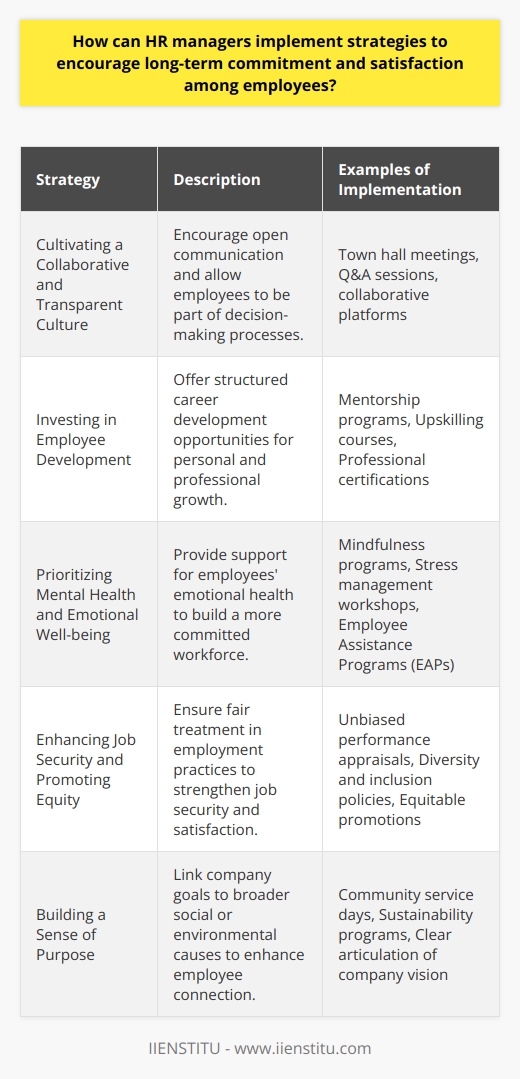
As a HR professional, how can one identify and address the key factors that contribute to employee attrition?
Identifying Key Factors
As a HR professional, it is crucial to identify and address the key factors that contribute to employee attrition. Attrition results in significant costs for companies, including recruitment, training, and productivity loss. Understanding the main drivers of attrition enables HR professionals to implement effective strategies to retain talent and maintain organizational effectiveness.
Employee Engagement
One of the primary factors contributing to attrition is a lack of employee engagement. Disengaged employees are less motivated, less committed, and more prone to seek employment elsewhere. HR professionals can measure employee engagement through regular surveys, feedback sessions, and performance reviews. By identifying areas for improvement, HR can create initiatives to boost engagement and reduce attrition.
Work-Life Balance
Many employees leave jobs due to an imbalance between work and personal life. Encouraging a healthy work-life balance helps in retaining valuable employees. HR professionals can offer flexible working arrangements, telecommuting options, and support for employees with family or other personal responsibilities. This not only improves employee satisfaction but also reduces stress and burnout.
Compensation and Benefits
Competitive compensation and benefits packages attract and retain employees. HR professionals must regularly assess the competitiveness of their offerings by researching industry standards and benchmarking against similar organizations. By adjusting compensation and benefits as needed, companies demonstrate that they value their employees and are committed to their well-being.
Training and Development Opportunities
Employees often leave organizations when they perceive limited opportunities for growth and development. HR professionals must ensure that employees have access to necessary training and development programs to advance their careers. By investing in employees, organizations enhance their skills and demonstrate a commitment to their long-term career success.
Work Environment and Culture
A positive work environment and organizational culture are critical to employee retention. HR professionals must ensure that the company culture promotes open communication, collaboration, and respect among colleagues. Implementing policies and practices that promote inclusivity, diversity, and fairness contributes to a positive work culture, leading to higher employee satisfaction and reduced attrition.
In conclusion, HR professionals play a crucial role in identifying and addressing the key factors contributing to employee attrition. By fostering engagement, offering competitive compensation and benefits, promoting work-life balance, providing development opportunities, and cultivating a positive work environment, HR professionals can reduce attrition rates while promoting organizational success.
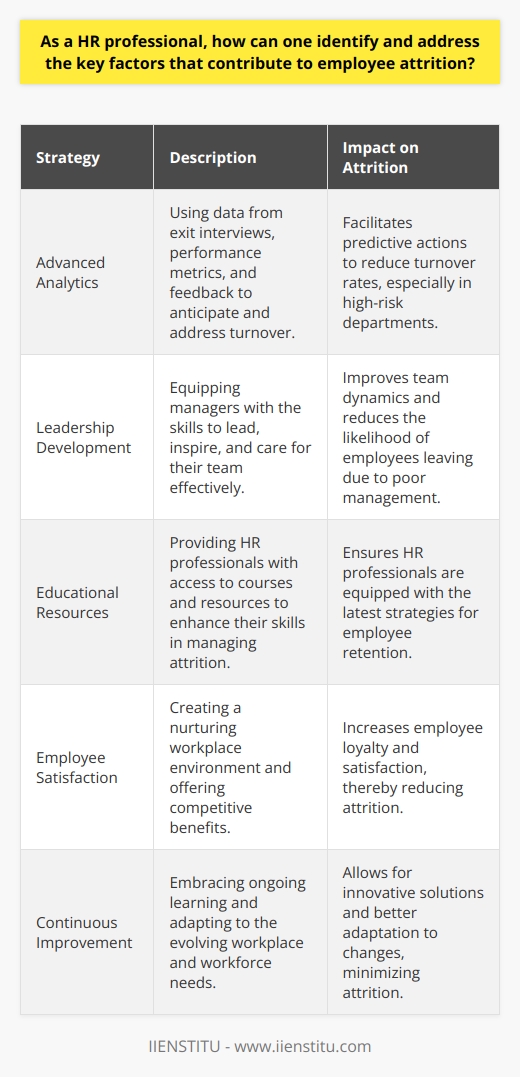
What is the comprehensive approach of HR in addressing the diverse factors influencing employee retention?
Comprehensive Approach of HR in Employee Retention
Understanding Employee Needs
The comprehensive approach of Human Resources (HR) in addressing diverse factors influencing employee retention begins with understanding employee needs. HR professionals must identify the unique needs of their workforce and develop targeted strategies to meet these needs, hence fostering job satisfaction and loyalty.
Effective Communication
Effective communication is essential in addressing employee retention. HR must establish open communication channels, allowing employees to express their opinions and concerns regarding their job tasks, performance evaluations, and career development. This feedback-driven communication culture enables HR to address an employee's issues promptly, resulting in improved retention rates.
Employee Training and Development
HR plays a vital role in providing continuous employee training and development opportunities. This not only enhances an employee's skills and competencies but also boosts their confidence and commitment to their organization. Furthermore, offering a clear career path and growth opportunities contributes significantly to retaining high-performing employees.
Work-Life Balance
Promoting work-life balance is another critical aspect of the comprehensive HR approach to employee retention. HR professionals should create flexible working policies, facilitate stress management initiatives, and engagements that allow employees to maintain a healthy balance between their work and personal lives. This not only fosters employee satisfaction but also helps in retaining top talent.
Competitive Compensation and Benefits
Offering competitive compensation and benefits packages is key to attracting and retaining a diverse and talented workforce. HR teams must regularly review and update these packages to ensure they remain attractive to current and potential employees. Additionally, recognizing employee success and contribution through awards and incentives can positively impact employee retention rates.
Addressing Workplace Culture
Establishing a workplace culture that supports diversity and inclusion is important in retaining employees. HR professionals should foster an environment where employees of all backgrounds feel respected and valued. Implementing anti-discrimination policies and conducting regular culture audits can help ensure the organization maintains an inclusive and supportive working environment.
Overall, the comprehensive approach of HR in addressing the diverse factors influencing employee retention necessitates a holistic understanding of employee needs, effective communication, employee training and development, work-life balance, competitive compensation and benefits, and fostering an inclusive workplace culture. By focusing on these diverse factors, HR professionals can significantly improve employee retention and contribute to organizational success.
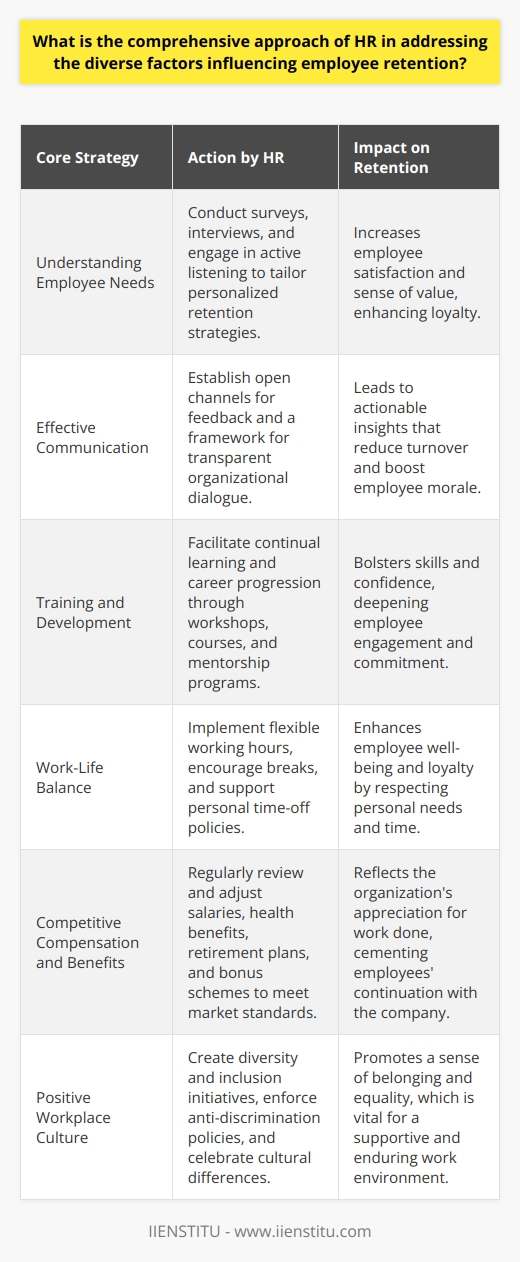
How does the application of HR theory and best practices contribute to the reduction of employee turnover rates?
Understanding HR Theories and Best Practices
To successfully reduce employee turnover rates, it is vital to understand and apply Human Resource (HR) theory and best practices. HR theory addresses key organizational and management aspects, such as recruitment and selection, employee engagement, talent management, training, and retention strategies. By implementing these practices, organizations can create a positive work environment, increasing employee satisfaction and reducing turnover rates.
Recruitment and Selection Process
The recruitment and selection process is the foundation of low employee turnover rates. HR theory emphasizes the importance of hiring the right candidates who align with the organization's culture and goals. Conducting comprehensive interviews, background checks, and reference checks ensure a proper fit within the organization, ultimately leading to higher job satisfaction and reduced turnover.
Employee Engagement
Employee engagement plays a crucial role in decreasing turnover rates. Implementing HR best practices, such as open communication and feedback systems, encourages employees to be more invested in their work. Fostering a sense of belonging through team-building activities and recognition programs also leads to increased commitment and loyalty, further reducing turnover rates.
Talent Management
By focusing on talent management, organizations can identify, motivate, and retain top talent, ultimately reducing employee turnover. HR theory supports strategies like performance appraisals and career development planning, ensuring employees feel valued and supported in their professional growth. These practices not only help retain high-performing employees, but also enhance overall productivity and organizational success.
Training and Development
Providing employees with relevant and timely training and development opportunities is another crucial aspect of HR theory that contributes to reduced turnover rates. Offering both on-the-job and off-the-job training, as well as mentorship programs, enables employees to expand their skill sets and stay engaged in their roles. This approach also fosters career growth, which in turn reduces the likelihood of employees seeking opportunities elsewhere.
Retention Strategies
Finally, implementing tailored retention strategies is essential for reducing employee turnover. HR best practices include competitive compensation packages, flexible work arrangements, and effective communication strategies to address employee concerns. By offering comprehensive benefits and maintaining open lines of communication, organizations can create a positive work environment that encourages employee satisfaction and loyalty.
In conclusion, the application of HR theory and best practices significantly contributes to the reduction of employee turnover rates. By focusing on recruitment and selection, employee engagement, talent management, training and development, and retention strategies, organizations can create a supportive and engaging workforce, ultimately leading to increased satisfaction and reduced turnover rates.
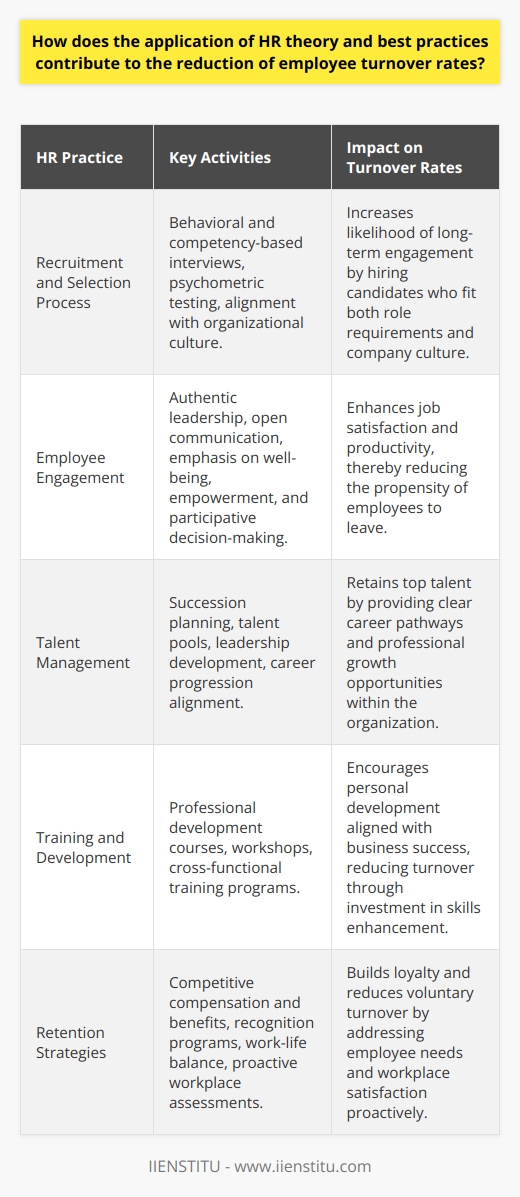
In what ways can HR professionals effectively measure and monitor employee retention within their organizations?
**Determining the Need for Retention Strategies**
To effectively measure and monitor employee retention, HR professionals can begin by assessing the organization's current retention levels. This involves tracking key performance indicators (KPIs), such as turnover rates and employee tenure. Organizations with low turnover rates and longer employee tenure are likely experiencing successful retention efforts.
**Implementing Retention Assessment Tools**
There is an array of tools and techniques available for HR professionals to assess employee retention. One such tool is the employee satisfaction survey, which can gauge employee engagement and satisfaction levels. Regularly conducting these surveys and analyzing the results can help HR professionals identify trends and areas for improvement. Additionally, exit interviews can provide valuable insights into the reasons behind employees' decisions to leave the organization, allowing HR teams to address these factors and improve retention.
**Monitoring Key Metrics**
It is essential for HR professionals to monitor specific metrics to effectively measure and manage employee retention. These metrics can include turnover rates, cost of turnover, time to fill open positions, and employee referral rates. By regularly evaluating these metrics, organizations can identify areas of concern and implement targeted retention strategies.
**Setting Retention Goals**
To facilitate effective employee retention management, HR professionals should set clear and attainable goals for their organizations. These goals can include targets for reducing turnover rates, improving employee satisfaction, increasing employee tenure, and enhancing workplace culture. Regularly monitoring progress towards these goals can help HR professionals determine the success of their strategies and make adjustments as needed.
**Evaluating the Impact of Retention Strategies**
Finally, it is crucial for HR professionals to evaluate the success of their retention strategies to ensure their efforts are yielding the desired results. By analyzing key metrics and comparing them with set goals, HR teams can identify whether their strategies are having a positive impact on employee retention. Additionally, soliciting employee feedback on implemented retention initiatives can help organizations refine and improve their strategies.
In conclusion, HR professionals can effectively measure and monitor employee retention by determining the need for retention strategies, implementing assessment tools, monitoring key metrics, setting retention goals, and evaluating the impact of their strategies. By doing so, organizations can enhance employee satisfaction, reduce turnover rates, and create a more stable, productive workforce.

What is the role of HR in implementing effective employee retention strategies?
Role of HR in Retention Strategies
Human Resources Planning
Human resources (HR) plays a crucial role in implementing effective employee retention strategies by anticipating and addressing potential workforce challenges. This includes analyzing labor market trends, assessing organizational needs, and creating strategic plans for hiring and retaining employees.
Attracting and Hiring the Right Talent
HR is responsible for attracting candidates who possess the necessary skills and competencies and align with the organization's core values. By developing comprehensive job descriptions and utilizing targeted recruitment methods, HR ensures a solid foundation for employee retention from the onset.
Performance Management and Feedback
The implementation of fair and transparent performance management procedures is another key area of responsibility for HR. By establishing clear objectives, providing regular feedback, and conducting performance appraisals, HR helps employees understand and achieve their potential, contributing to overall job satisfaction and retention.
Employee Development and Advancement
To retain top talent, HR implements systems for employee development and advancement, focusing on professional growth and career progression opportunities. These systems include training programs, leadership development initiatives, and mentorship opportunities, all aimed at fostering an environment conducive to employee engagement and long-term commitment.
Work-Life Balance
HR is instrumental in promoting work-life balance within the organization, recognizing the importance of employee well-being on retention. Flexible work arrangements, remote work options, and employee assistance programs are all examples of strategies HR can employ to address employee needs and foster loyalty.
Recognition and Reward Programs
Implementing recognition and reward programs is another key aspect of HR's role in employee retention. By recognizing and celebrating the achievements of employees, HR fosters a sense of belonging and enhances motivation to excel within the organization.
Workplace Culture
Finally, HR helps to shape a positive workplace culture, essential for employee retention. By fostering effective communication channels, promoting teamwork and collaboration, and encouraging diversity and inclusion, HR contributes to the creation of a supportive and engaging work environment that employees are proud to be a part of.
In conclusion, HR plays a multifaceted role in implementing effective employee retention strategies. By planning proactively, attracting and hiring the right talent, managing performance, facilitating development and advancement, promoting work-life balance, implementing recognition and reward programs, and nurturing a positive workplace culture, HR can significantly influence employee engagement, satisfaction, and loyalty.
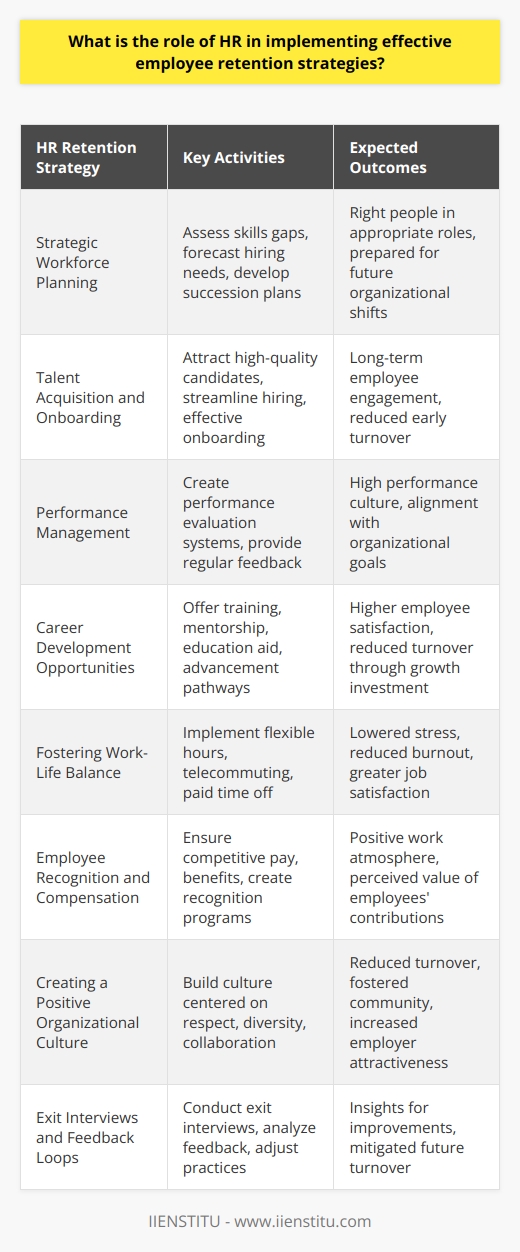
How can HR management integrate theoretical concepts to optimize employee retention rates within an organization?
Understanding Theoretical Concepts
To optimize employee retention rates within an organization, HR management must first understand the key theoretical concepts surrounding employee retention. This includes understanding motivational theories, such as Maslow's Hierarchy of Needs and Herzberg's Two-Factor Theory, as well as employee engagement and organizational behavior theories.
Applying Theories to Retention Strategies
Once familiar with these theories, the HR management can incorporate them into the development and implementation of retention strategies. For example, applying Maslow's Hierarchy of Needs would involve ensuring that employees' basic needs (such as financial security and a safe working environment) are met while also considering higher-level needs, such as self-esteem, belonging, and self-actualization.
Communicating Expectations and Support
Another important aspect of integrating theoretical concepts in employee retention management is ensuring open communication within the organization. This involves setting clear expectations for employees in terms of job responsibilities, performance goals, and growth opportunities. In addition, HR management should create a supportive environment that facilitates two-way communication, empowering employees to express their concerns and ideas.
Engaging Employees through Feedback
Incorporating an effective feedback system in the organization is crucial for retaining employees. This may involve regular employee performance evaluations and anonymous surveys for employees to provide feedback on their work environment and their perceived level of support. By assessing this feedback and taking action to address concerns, HR management can create an environment that allows employees to feel valued and engaged, ultimately leading to better retention rates.
Developing a Growth-Oriented Culture
Lastly, fostering a growth-oriented culture within the organization is essential for employee retention. In practice, this means providing employees with ongoing opportunities for learning and development through mentorship, training programs, and on-the-job experiences. By aligning employees' career aspirations with the organization's goals, HR management can build a foundation for sustained employee engagement and loyalty.
In conclusion, HR management can integrate theoretical concepts to optimize employee retention rates within an organization by understanding and applying these key theories, utilizing open communication, incorporating feedback systems, and fostering a growth-oriented culture. When these strategies are put into practice, organizations can benefit from a stable and engaged workforce, ultimately leading to increased productivity and success.
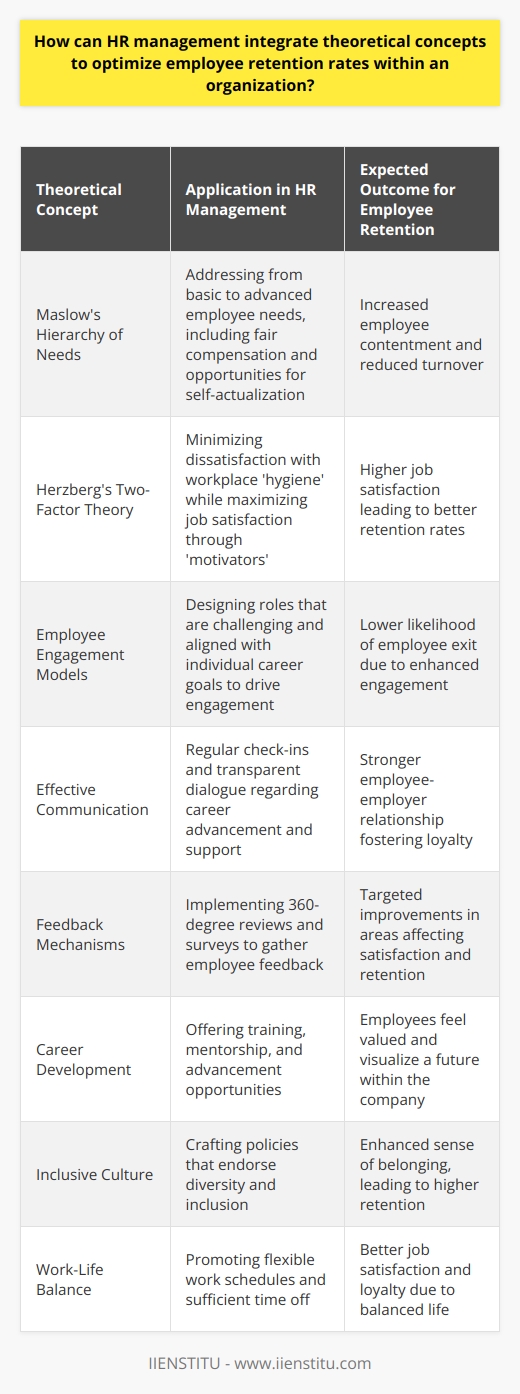
What are the key components of a comprehensive HR retention plan that addresses various employee needs and motivations?
Retention Strategies
A comprehensive HR retention plan must consider several key components to effectively address employees' varying needs and motivations. The main elements encompass competitive compensation, professional development opportunities, flexible work arrangements, a positive organizational culture, and employee recognition.
Competitive Compensation
The first critical component is offering competitive remuneration packages that include salary, benefits, and incentives. This ensures that employees feel fairly compensated for their work and prevents them from seeking more attractive opportunities elsewhere in the job market.
Professional Development
Next, the retention plan must facilitate opportunities for employees to grow and develop within the organization. This involves providing continuous training, workshops, mentorship programs, and clear career paths for advancement. By investing in employees' professional growth, organizations can cultivate a highly skilled workforce and foster company loyalty.
Flexible Work Arrangements
Offering flexible work arrangements such as telecommuting, flextime, and job sharing can significantly increase employee satisfaction and loyalty. These options cater to diverse employee needs, such as work-life balance and personal preferences, ultimately contributing to a stable and content workforce.
Organizational Culture
Creating a positive organizational culture that promotes inclusivity, teamwork, and open communication is essential for employee retention. Establishing strong ties among team members and fostering a collaborative work environment helps employees feel connected and valued, reducing the likelihood of voluntary departures.
Employee Recognition
Lastly, incorporating employee recognition initiatives into the retention plan can effectively boost motivation and job satisfaction. Organizations should consistently acknowledge milestones, achievements, and exceptional performance of employees, demonstrating appreciation for their efforts and fostering a sense of pride and loyalty in the workplace.
In summary, a comprehensive HR retention plan must encompass various vital components to address the diverse needs and motivations of employees effectively. By focusing on areas such as competitive compensation, professional development opportunities, flexible work options, positive organizational culture, and employee recognition, organizations can improve employee satisfaction and reduce turnover rates, resulting in a stable, skilled, and motivated workforce.
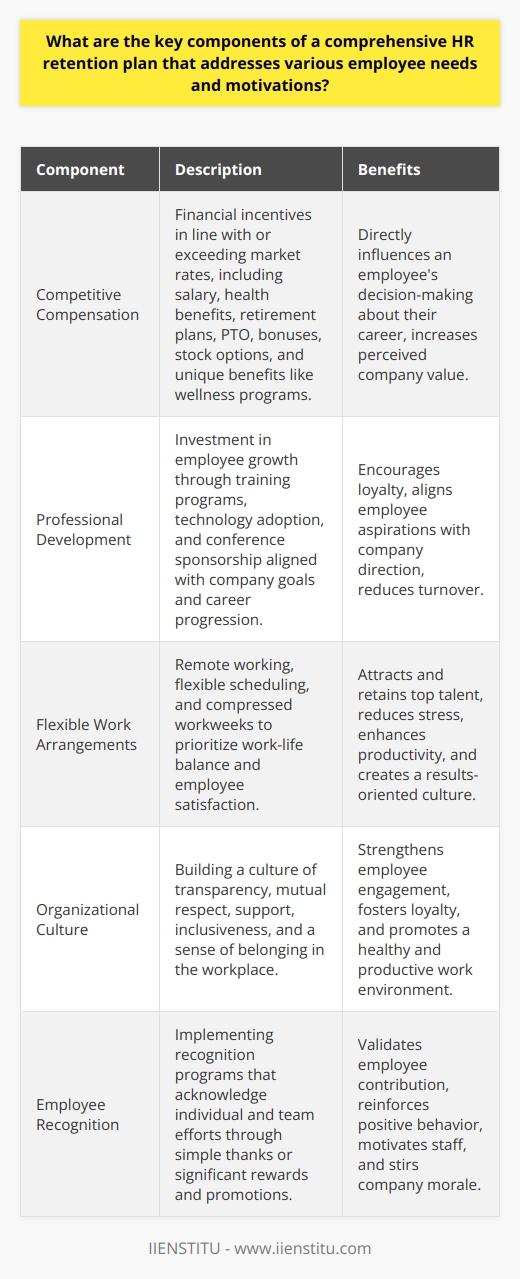
How does HR improve employee retention by addressing the individual needs and motivations of employees?
Understanding Employee Needs
Human Resources (HR) plays a vital role in employee retention by accurately understanding and addressing the individual needs and motivations of employees. HR activities engage with employees to identify their needs for job satisfaction, personal growth, and work-life balance. Regular interaction, open communication, and HR's participation help to establish trust among employees, contributing to retaining them.
Role of Evaluation and Recognition
HR needs to evaluate employee performance regularly and recognize their contributions. This recognition not only boosts employee morale but also instills a sense of belonging. It is a key motivational factor that can result in enhanced productivity and commitment, fostering employee loyalty.
Importance of Training and Development
HR improves retention by providing opportunities for career growth through training and development programs. These initiatives address employees' intrinsic motivation for self-improvement, while also fostering competency, adaptability, and productivity. By investing in employees' skills development, HR shows employees that they are valued, thereby improving retention.
Impact of Effective Communication
Effective communication is another tool utilized by HR to improve employee retention. Information sharing and transparency can alleviate employees' sense of uncertainty and anxiety, contributing to their job satisfaction and commitment to the organization.
Offering a Comfortable Work Environment
Finally, HR plays a significant role in ensuring a comfortable and inclusive work environment, which is crucial for retention. Without fear of bias or discrimination, employees can work to their full potential. This, in combination with the strategies discussed before, can significantly enhance employee retention rates within an organization.
In conclusion, the HR department plays a central role in employee retention by addressing individual needs and motivations through recognition, training and development, communication, and fostering a conducive work environment.
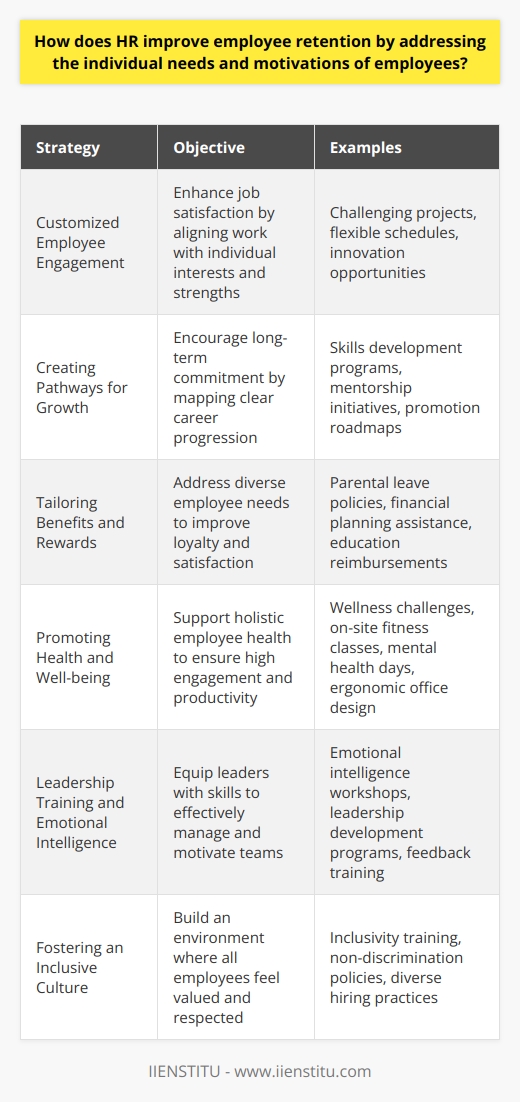
Is employee retention an HR issue that requires both strategic planning and proactive measures?
Role of HR in Employee Retention
Considering the prevalent competitive business scenario, employee retention has undeniably become a crucial HR issue. It requires strategic planning and proactive measures simultaneously.
Strategic Planning Approach
Strategic planning involves considering long-term goals and aligning HR practices accordingly. Retention strategies like career development initiatives, competitive compensation and a positive work environment fall into this category. The aim here is to create an employee-centric environment that encourages a long-term stay.
Proactive Measures in Retention
Proactive measures refer to the HR's active involvement in identifying the reasons for employee turnover and addressing them promptly. These might include identifying dissatisfaction elements, conducting regular feedback sessions, and implementing changes based on these feedbacks. Besides, HR also needs to ensure effective communication and recognition for enhancing job satisfaction.
The Intersection of Both
Both strategic planning and proactive measures are not mutually exclusive but significantly intertwined when addressing employee retention. Strategic planning helps to establish a robust foundation while proactive measures equip HR to respond quickly to emerging issues.
Therefore, ensuring employee retention is indeed an HR issue that necessitates both strategic planning and proactive measures for its effective implementation. This dual approach of planning and acting can significantly help organizations retain valuable employees, thereby fostering continued business growth.
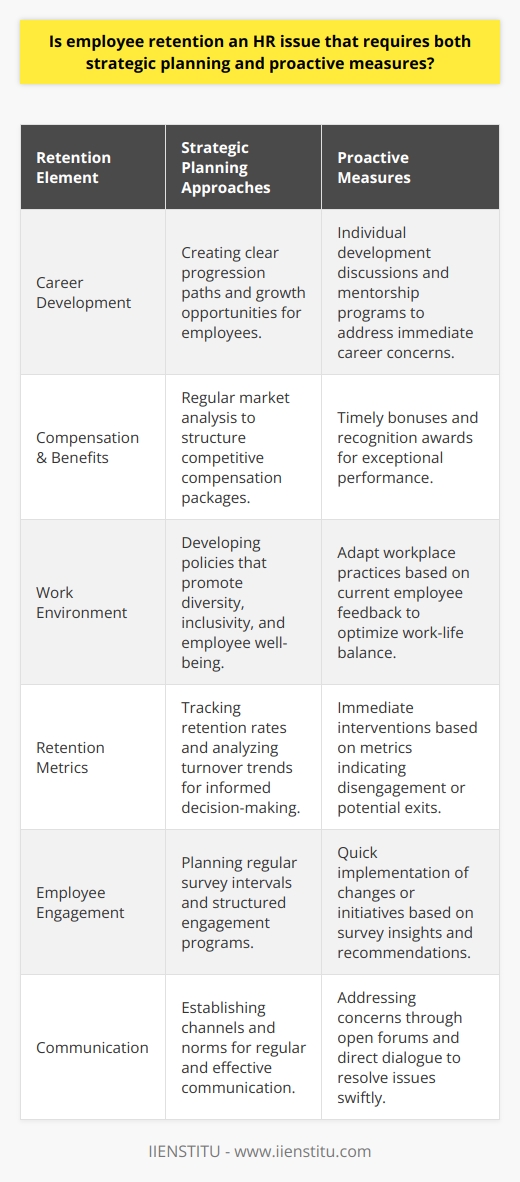
Has employee retention become a top priority for human resources due to long-term organizational success and competitive advantage?
Importance of Employee Retention for HR
Indeed, employee retention has become a high priority for human resources. This trend is driven mainly by its significant impact on the long-term success of organizations.
Impact on Organizational Success
Organizations with high employee retention rates often experience increased productivity, improved morale, and higher customer satisfaction. These factors contribute to the company's overall performance, leading to long-term success. Hence, HR departments are now giving more attention to employee retention strategies.
Advantage over Competitors
Additionally, retaining employees provides a competitive advantage for organizations. Companies with low turnover rates possess experienced and skilled personnel who have a deep understanding of business operations. This expertise is invaluable in today’s competitive market.
Role of HR in Employee Retention
HR plays a crucial role in ensuring employee retention. They design and implement strategies to engage employees effectively. These might include competitive remuneration packages, opportunities for personal growth, and fostering a healthy work environment.
Conclusion
In conclusion, employee retention has indeed become a top priority for human resources. It's clear that higher retention rates contribute to organizational success and give companies a competitive edge. Therefore, modern HR departments must focus on employee engagement as a means to improve retention and ultimately, their organization's performance.
